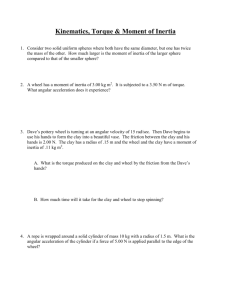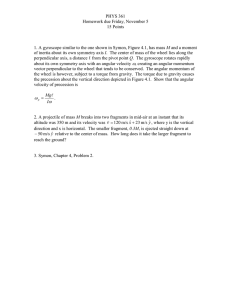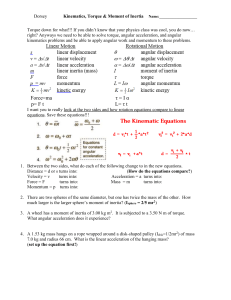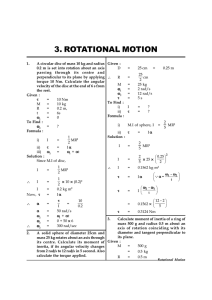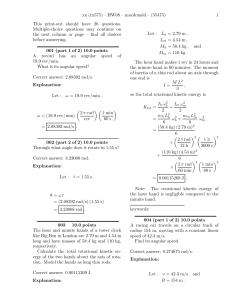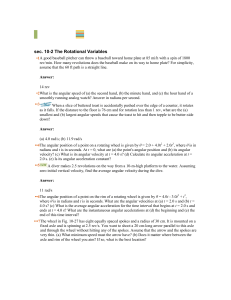HW#9a MIDTERM 2 INCLUDES HW 5a to 9a!!!
advertisement
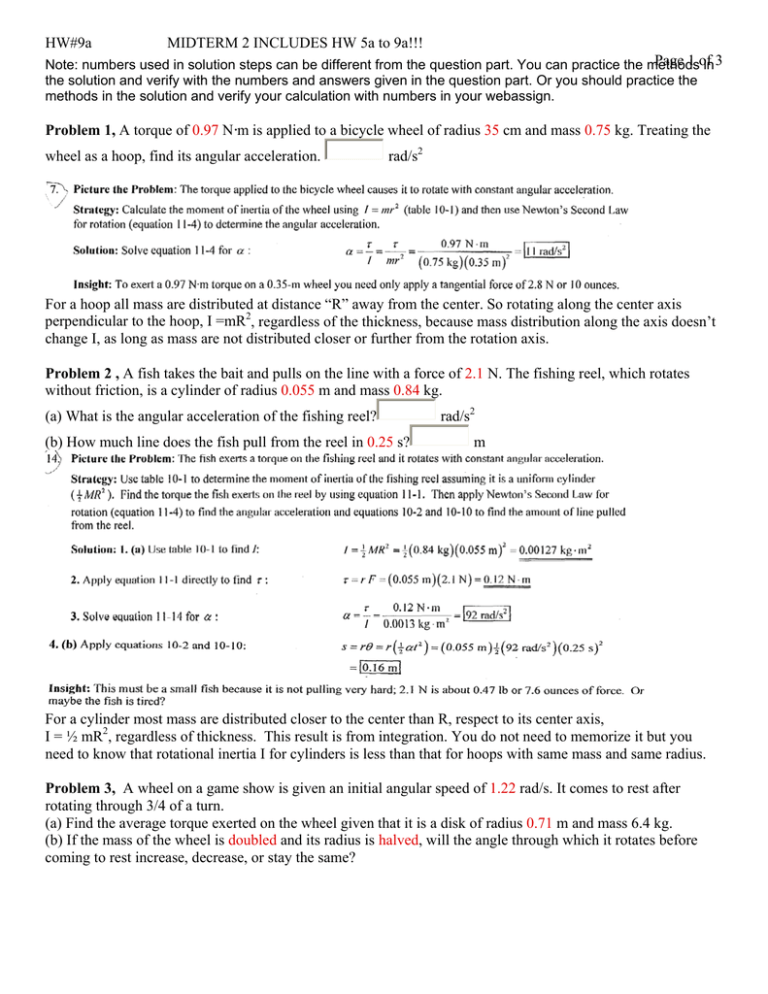
HW#9a MIDTERM 2 INCLUDES HW 5a to 9a!!! Page 1 of Note: numbers used in solution steps can be different from the question part. You can practice the methods in 3 the solution and verify with the numbers and answers given in the question part. Or you should practice the methods in the solution and verify your calculation with numbers in your webassign. Problem 1, A torque of 0.97 N·m is applied to a bicycle wheel of radius 35 cm and mass 0.75 kg. Treating the wheel as a hoop, find its angular acceleration. rad/s2 For a hoop all mass are distributed at distance “R” away from the center. So rotating along the center axis perpendicular to the hoop, I =mR2, regardless of the thickness, because mass distribution along the axis doesn’t change I, as long as mass are not distributed closer or further from the rotation axis. Problem 2 , A fish takes the bait and pulls on the line with a force of 2.1 N. The fishing reel, which rotates without friction, is a cylinder of radius 0.055 m and mass 0.84 kg. (a) What is the angular acceleration of the fishing reel? (b) How much line does the fish pull from the reel in 0.25 s? rad/s2 m For a cylinder most mass are distributed closer to the center than R, respect to its center axis, I = ½ mR2, regardless of thickness. This result is from integration. You do not need to memorize it but you need to know that rotational inertia I for cylinders is less than that for hoops with same mass and same radius. Problem 3, A wheel on a game show is given an initial angular speed of 1.22 rad/s. It comes to rest after rotating through 3/4 of a turn. (a) Find the average torque exerted on the wheel given that it is a disk of radius 0.71 m and mass 6.4 kg. (b) If the mass of the wheel is doubled and its radius is halved, will the angle through which it rotates before coming to rest increase, decrease, or stay the same? HW#9a MIDTERM 2 INCLUDES HW 5a to 9a!!! Page 2 of 3 Be very careful about the square dependence on R. I = ½ mR2 On the other hand, if the mass of the wheel is halved and its radius is doubled , the new I will be 1 2 ⎛M ⎞ ⎡1 ⎤ I = MR 2 → 12 ⎜ ⎟ ( 2 R ) = 2 ⎢ MR 2 ⎥ = twice of the old I. In that case, the moment of inertia doubles. 2 ⎝ 2 ⎠ ⎣2 ⎦ With the same torque, the angular acceleration will decrease by a factor of 1/2. So, the wheel is spinning for longer before reducing its angular velocity to zero, and the angle traveled increases. Problem 4, A 2 kg mass and a 5 kg mass are attached to either end of a 3 m long massless rod. a.) Find the center of mass of the system. m1 m, from the 2 kg mass. m2 x 0 L Find the rotational inertia (I) of the system when rotated about: b.) the end with the 2 kg mass. kg m2 c.) the end with the 5 kg mass. kg m2 d.) the center of the rod. kg m2 e.) the center of mass of the system. kg m2 (Compare this to parts b-d. Is this what you expect?) f.) If the system is rotated about the center of mass by a force of 8 N acting on the 5 kg mass, (perpendicular to the rod), what will the size of the angular acceleration of the system be? rad/s2 Solution. (a) We will calculate the x-coordinate of the CM, with x = 0 at the position of the smaller mass, as shown. 1 1 X CM = ( m1 x1 + m2 x2 ) = ( ( 2 kg )( 0 ) + ( 5 kg )( 3 m ) ) = 2.143 m m1 + m2 ( 7 kg ) It makes sense that CM is closer to the larger mass. (b) To find the rotational inertia (the moment of inertia I) about various points, we will use the simple expression for point masses, Here we do not consider the size and radius of the masses. The question was asking as if the masses are mass points. I = m1r12+ m2r22 2 Rotating around to the left end, r1=0, I = m2 L2 = ( 5 kg )( 3 m ) = 45 kg-m 2 (c) Now Rotating around to the right end, r2=0: HW#9a MIDTERM 2 INCLUDES HW 5a to 9a!!! I = m1 L2 = ( 2 kg )( 3 m ) = 18 kg-m 2 2 Page 3 of 3 (d) Now about the point x = L/2: 2 2 2 2 ⎛L⎞ ⎛L⎞ I = m1 ⎜ ⎟ + m2 ⎜ ⎟ = ( 2 kg )(1.5 m ) + ( 5 kg )(1.5 m ) = 15.75 kg-m 2 ⎝2⎠ ⎝2⎠ (e) About x = 2.143 m: 2 2 2 2 I = m1 ( 2.143 m ) + m2 ( L − 2.143 m ) = ( 2 kg )( 2.143 m ) + ( 5 kg )( 0.857 m ) = 12.86 kg-m 2 It is interesting to notice that the minimum moment of inertia is always about the CM. As we discussed in the class. CM is a special point where all mass points are distributed not too far away from it. CM minimizes its distance to all mass points. As a result, when the system rotates around any other axis, the masses are distributed further from the axis than to the CM, hence the moment of inertia respect to any other axis will be more than that respect to the CM. (f) The torque about the CM from this force would be equal to the force times the distance from where it acts to the CM: τ = Fd = ( 8 N )( 0.857 m ) = 6.856 N-m This gives an angular acceleration of α= τ I = ( 6.856 N-m ) (12.86 kg-m ) 2 = 0.533 rad/s 2

